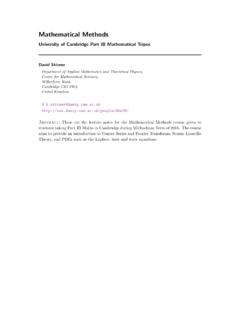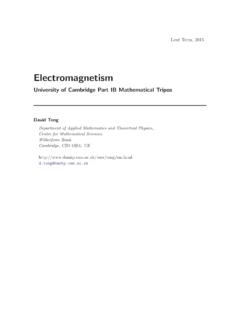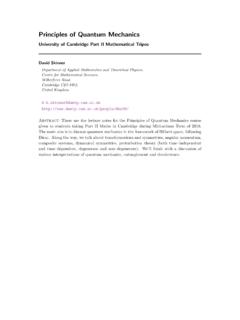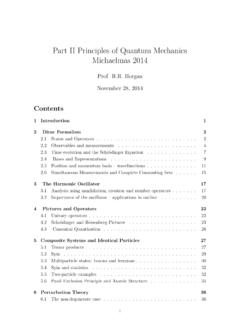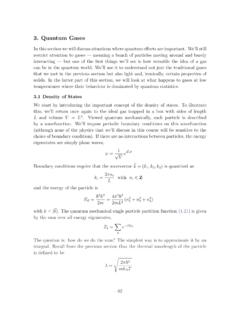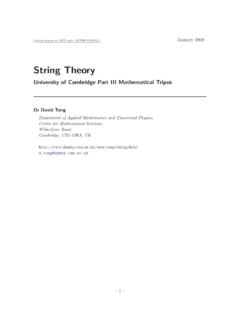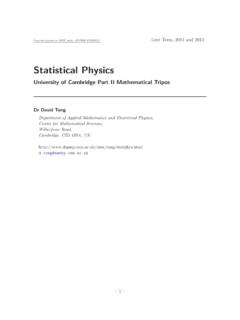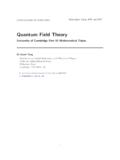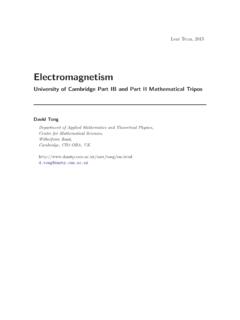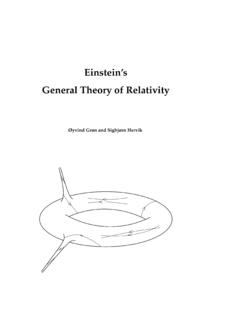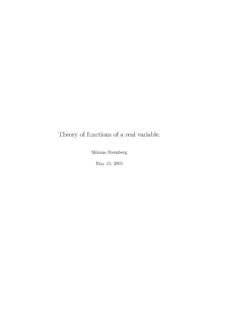Transcription of TASI Lectures on Solitons - DAMTP
1 Preprint typeset in JHEP style - PAPER VERSION June 2005. TASI Lectures on Solitons Instantons, Monopoles, Vortices and Kinks David Tong Department of Applied Mathematics and Theoretical Physics, Centre for Mathematical Sciences, Wilberforce Road, Cambridge, CB3 OBA, UK. Abstract: These Lectures cover aspects of Solitons with focus on applications to the quantum dynamics of supersymmetric gauge theories and string theory. The Lectures consist of four sections, each dealing with a different soliton . We start with instantons and work down in co-dimension to monopoles, vortices and, eventually, domain walls. Emphasis is placed on the moduli space of Solitons and, in particular, on the web of connections that links Solitons of different types. The D-brane realization of the ADHM and Nahm construction for instantons and monopoles is reviewed, together with related constructions for vortices and domain walls.
2 Each lecture ends with a series of vignettes detailing the roles Solitons play in the quantum dynamics of supersymmetric gauge theories in various dimensions. This includes applications to the AdS/CFT. correspondence, little string theory, S-duality, cosmic strings, and the quantitative correspondence between 2d sigma models and 4d gauge theories. Contents 0. Introduction 4. 1. Instantons 6. The Basics 6. The Instanton Equations 8. Collective Coordinates 9. The Moduli Space 11. The Moduli Space Metric 13. An Example: A Single Instanton in SU(2) 14. Fermi Zero Modes 16. Dimension Hopping 17. Instantons and Supersymmetry 17. The ADHM Construction 20. The Metric on the Higgs Branch 23. Constructing the Solutions 24. Non-Commutative Instantons 28. Examples of Instanton Moduli Spaces 29. Applications 31. Instantons and the AdS/CFT Correspondence 31.
3 Instanton Particles and the (2, 0) Theory 34. 2. Monopoles 39. The Basics 39. Dirac Quantization Condition 41. The Monopole Equations 43. Solutions and Collective Coordinates 44. The Moduli Space 45. The Moduli Space Metric 46. The Physical Interpretation of the Metric 46. Examples of Monopole Moduli Spaces 48. Dyons 51. Fermi Zero Modes 53. Nahm's Equations 53. Constructing the Solutions 57. 1 . What Became of Instantons 59. Applications 61. Monopoles in Three Dimensions 62. Monopoles and Duality 63. Monopole Strings and the (2, 0) Theory 65. D-Branes in Little String Theory 67. 3. Vortices 71. The Basics 71. The Vortex Equations 73. The Moduli Space 75. The Moduli Space Metric 76. Examples of Vortex Moduli Spaces 77. Brane Construction 79. Examples of Vortex Moduli Spaces Revisited 82. The Relationship to Instantons 83.
4 Adding Flavors 84. Non-Commutative Vortices 86. What Became 86. Monopoles 86. Instantons 87. Fermi Zero Modes 88. Applications 89. Vortices and Mirror Symmetry 90. Swapping Vortices and Electrons 90. Vortex Strings 92. 4. Domain Walls 95. The Basics 95. Domain Wall Equations 96. An Example 97. Classification of Domain Walls 98. The Moduli Space 99. The Moduli Space Metric 99. Examples of Domain Wall Moduli Spaces 100. Dyonic Domain Walls 101. The Ordering of Domain Walls 103. What Became 105. 2 . Vortices 105. Monopoles 107. Instantons 110. The Quantum Vortex String 111. The Brane Construction 113. The Ordering of Domain Walls Revisited 115. The Relationship to Monopoles 117. Applications 117. Domain Walls and the 2d Black Hole 117. Field Theory D-Branes 119. 3 . 0. Introduction 170 years ago, a Scotsman on horseback watched a wave travelling down Edinburgh's Union canal.
5 He was so impressed that he followed the wave for several miles, described the day of observation as the happiest of his life, and later attempted to recreate the experience in his own garden. The man's name was John Scott Russell and he is generally credited as the first person to develop an unhealthy obsession with the singular and beautiful phenomenon that we now call a soliton . Russell was ahead of his time. The features of stability and persistence that so impressed him were not appreciated by his contemporaries, with Airy arguing that the great primary wave was neither great nor primary1 . It wasn't until the following century that Solitons were understood to play an important role in areas ranging from engineering to biology, from condensed matter to cosmology. The purpose of these Lectures is to explore the properties of Solitons in gauge theories.
6 There are four leading characters: the instanton, the monopole, the vortex, and the domain wall (also known as the kink). Most reviews of Solitons start with kinks and work their way up to the more complicated instantons. Here we're going to do things backwards and follow the natural path: instantons are great and primary, other Solitons follow. A major theme of these Lectures is to flesh out this claim by describing the web of inter-relationships connecting our four solitonic characters. Each lecture will follow a similar pattern. We start by deriving the soliton equations and examining the basic features of the simplest solution. We then move on to discuss the interactions of multiple Solitons , phrased in terms of the moduli space. For each type of soliton , D-brane techniques are employed to gain a better understanding of the relevant geometry.
7 Along the way, we shall discuss various issues including fermionic zero modes, dyonic excitations and non-commutative Solitons . We shall also see the earlier Solitons reappearing in surprising places, often nestling within the worldvolume of a larger soliton , with interesting consequences. Each lecture concludes with a few brief descriptions of the roles Solitons play in supersymmetric gauge theories in various dimensions. These notes are aimed at advanced graduate students who have some previous aware- ness of Solitons . The basics will be covered, but only very briefly. A useful primer on Solitons can be found in most modern field theory textbooks (see for example [1]). More 1. More background on Russell and his wave can be found at chris/scott and history/Mathematicians/Russell 4 . details are contained in the recent book by Manton and Sutcliffe [2].
8 There are also a number of good reviews dedicated to Solitons of a particular type and these will be mentioned at the beginning of the relevant lecture . Other background material that will be required for certain sections includes a basic knowledge of the structure of su- persymmetric gauge theories and D-brane dynamics. Good reviews of these subjects can be found in [3, 4, 5]. 5 . 1. Instantons 30 years after the discovery of Yang-Mills instantons [6], they continue to fascinate both physicists and mathematicians alike. They have lead to new insights into a wide range of phenomena, from the structure of the Yang-Mills vacuum [7, 8, 9] to the classification of four-manifolds [10]. One of the most powerful uses of instantons in recent years is in the analysis of supersymmetric gauge dynamics where they play a key role in unravelling the plexus of entangled dualities that relates different theories.
9 The purpose of this lecture is to review the classical properties of instantons, ending with some applications to the quantum dynamics of supersymmetric gauge theories. There exist many good reviews on the subject of instantons. The canonical reference for basics of the subject remains the beautiful lecture by Coleman [11]. More recent applications to supersymmetric theories are covered in detail in reviews by Shifman and Vainshtein [12] and by Dorey, Hollowood, Khoze and Mattis [13]. This latter review describes the ADHM construction of instantons and overlaps with the current lecture . The Basics The starting point for our journey is four-dimensional, pure SU(N) Yang-Mills theory with action2. 1. Z. S= 2 d4 x Tr F F ( ). 2e Motivated by the semi-classical evaluation of the path integral, we search for finite action solutions to the Euclidean equations of motion, D F = 0 ( ).
10 Which, in the imaginary time formulation of the theory, have the interpretation of mediating quantum mechanical tunnelling events. The requirement of finite action means that the potential A must become pure gauge as we head towards the boundary r of spatial R4 , A ig 1 g ( ). 2. Conventions: We pick Hemitian generators T m with Killing form Tr T m T n = 12 mn . We write A = Am T. m and F = A A i[A , A ]. Adjoint covariant derivatives are D X = X . i[A , X]. In this section alone we work with Euclidean signature and indices will wander from top to bottom with impunity; in the following sections we will return to Minkowski space with signature (+, , , ). 6 . with g(x) = eiT (x) SU(N). In this way, any finite action configuration provides a map from R4 = S3 into the group SU(N). As is well known, such maps are classified by homotopy theory.
